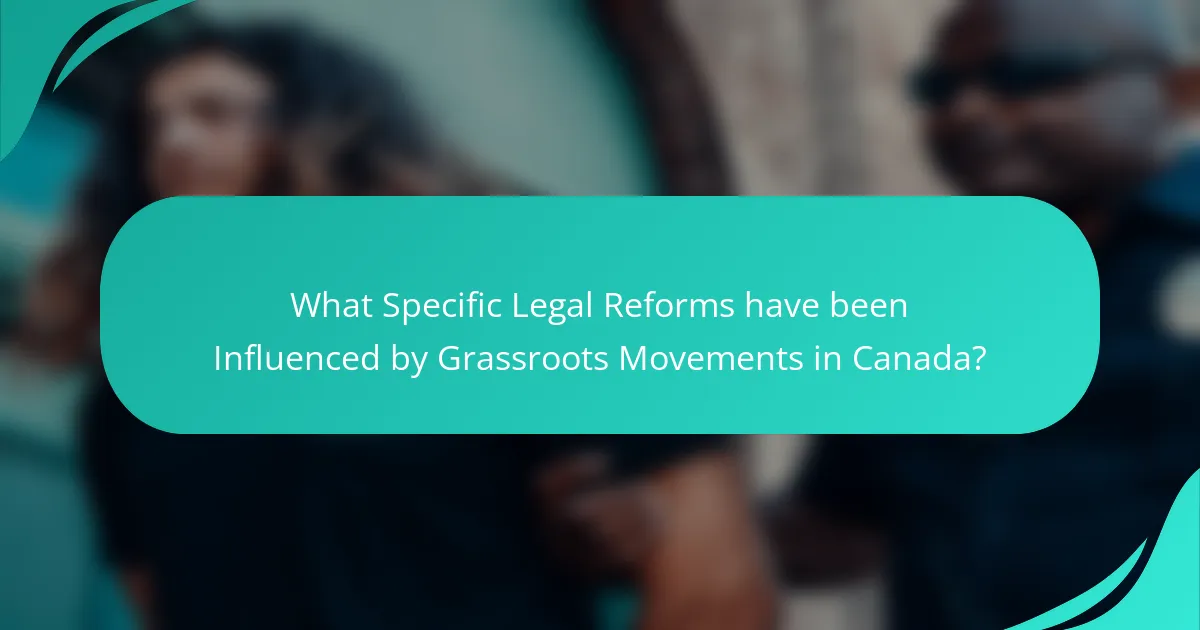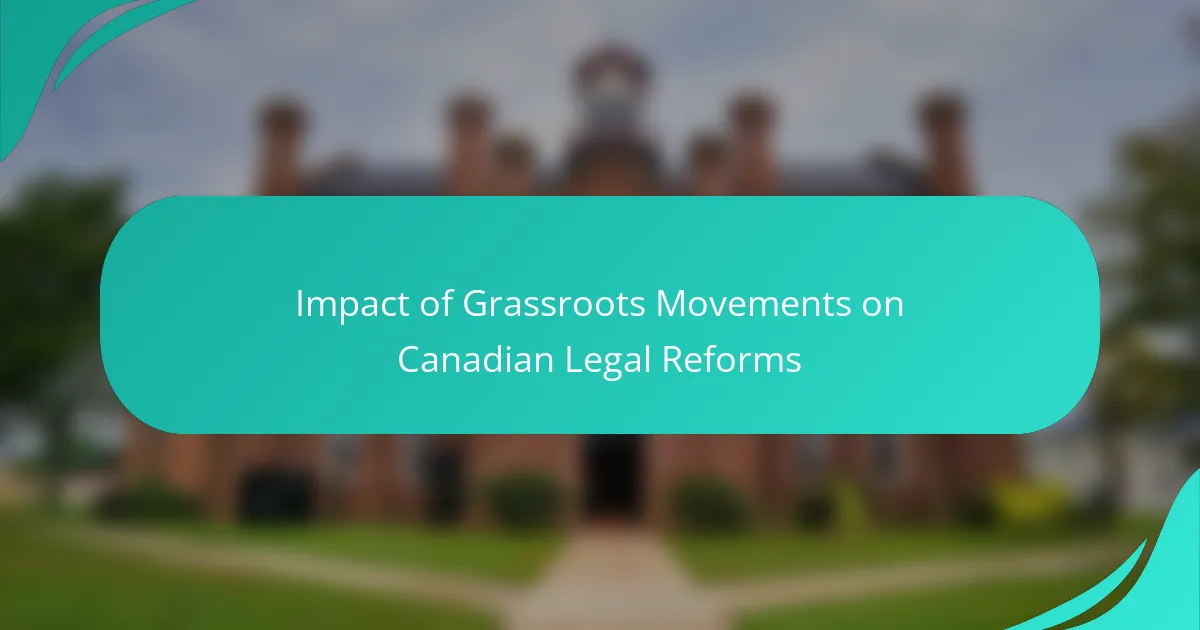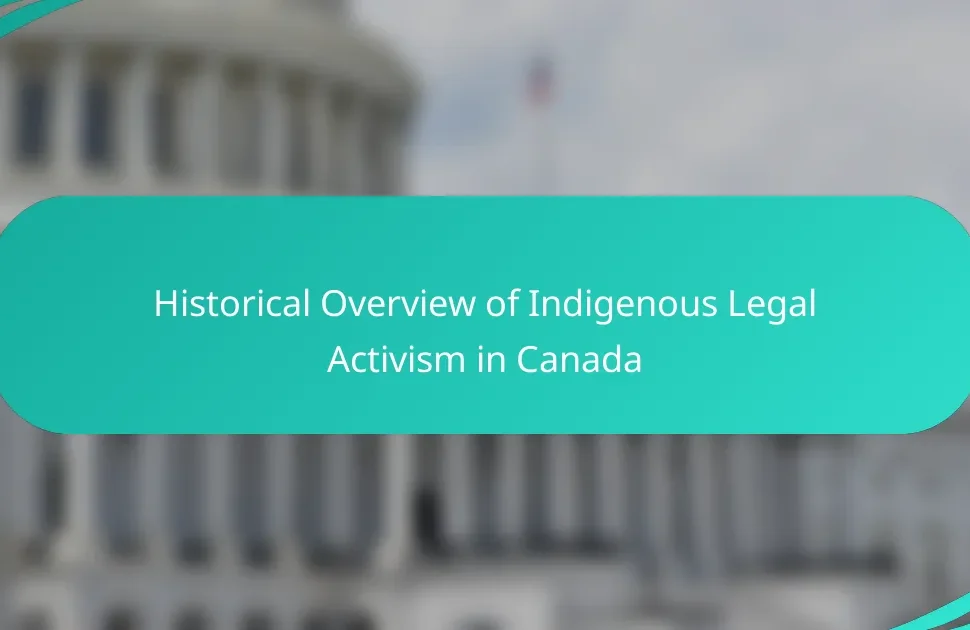
What are Grassroots Movements and Their Role in Legal Reforms?
Grassroots movements are organized efforts by ordinary people to effect social or political change. They often arise in response to perceived injustices or unmet needs within a community. These movements mobilize individuals to advocate for legal reforms that reflect the collective interests of the group.
In Canada, grassroots movements have played a significant role in shaping legal reforms. For example, the women’s suffrage movement led to the extension of voting rights to women in the early 20th century. More recently, Indigenous rights movements have influenced legal frameworks regarding land and resource management.
Research shows that grassroots activism can drive legislative change by raising public awareness and influencing policymakers. According to a study by the Canadian Centre for Policy Alternatives, community-led initiatives often lead to more equitable and representative legal outcomes. This evidence supports the idea that grassroots movements are vital in the legal reform process.
How do Grassroots Movements influence Canadian society?
Grassroots movements significantly influence Canadian society by advocating for social change and raising awareness on various issues. They mobilize communities to address concerns such as environmental protection, indigenous rights, and social justice. For instance, the Idle No More movement has highlighted indigenous issues, leading to increased dialogue about treaty rights and environmental stewardship. Additionally, grassroots initiatives often pressure government officials to enact policy changes. According to a 2019 study by the Canadian Centre for Policy Alternatives, grassroots activism has been pivotal in shaping public policy debates. This demonstrates that grassroots movements play a crucial role in fostering civic engagement and influencing legislative reforms in Canada.
What are the key characteristics of Grassroots Movements?
Grassroots movements are characterized by community-driven initiatives that prioritize local involvement. They typically emerge from the needs and concerns of ordinary people. These movements often focus on social, political, or environmental issues. They rely on collective action and mobilization of grassroots support. Grassroots movements emphasize inclusivity and democratic participation. They often utilize social media and digital platforms for outreach. Their success is frequently measured by community engagement and policy changes. Historical examples include the civil rights movement and environmental activism, highlighting their impact on broader societal reforms.
In what ways do Grassroots Movements mobilize communities?
Grassroots movements mobilize communities through collective action, awareness campaigns, and community organizing. They encourage individuals to unite for a common cause. These movements often utilize social media to spread their message quickly. They create platforms for dialogue among community members. Grassroots movements also provide training and resources to empower local leaders. They foster a sense of belonging and shared purpose within the community. Historical examples include the civil rights movement, which effectively mobilized communities to demand legal reforms. Statistics show that grassroots efforts can lead to significant policy changes, as seen in various Canadian legal reforms influenced by community activism.
Why are Grassroots Movements important for legal reforms?
Grassroots movements are crucial for legal reforms because they mobilize community support and raise awareness about specific issues. These movements often highlight injustices that may be overlooked by traditional political processes. They empower individuals to advocate for change, fostering a sense of ownership in the legal reform process. Historical examples show that grassroots efforts have successfully influenced legislation, such as the civil rights movement leading to the Civil Rights Act of 1964. Additionally, grassroots movements can pressure lawmakers to respond to public demands, ensuring that reforms reflect the needs of the community. In Canada, movements addressing issues like Indigenous rights have significantly shaped legal reforms, demonstrating their impact on policy change.
What historical examples illustrate the impact of Grassroots Movements on laws?
Grassroots movements have historically influenced laws significantly. One example is the women’s suffrage movement in Canada. Activists campaigned for voting rights, leading to the federal enfranchisement of women in 1918. Another notable instance is the Indigenous rights movement. Grassroots organizations advocated for land rights and self-governance, culminating in the 1982 Constitution Act, which recognized Indigenous rights. The anti-nuclear movement also serves as an example. Public protests and advocacy led to the Nuclear Safety and Control Act in 1997. These movements demonstrate how collective action can shape legal frameworks in Canada.
How do Grassroots Movements challenge existing legal frameworks?
Grassroots movements challenge existing legal frameworks by mobilizing community action to advocate for change. They raise awareness about social issues that may be overlooked by traditional political processes. These movements utilize protests, petitions, and social media to amplify their voices. They often highlight injustices and demand accountability from lawmakers. For example, the Idle No More movement in Canada focused on indigenous rights and environmental protection. This movement pressured the government to reconsider its policies affecting indigenous communities. Grassroots efforts can lead to legal reforms when they gain sufficient public support. Their ability to influence public opinion often compels lawmakers to respond to their demands.

What Specific Legal Reforms have been Influenced by Grassroots Movements in Canada?
Grassroots movements in Canada have influenced several specific legal reforms. One notable reform is the legalization of same-[censured] marriage in 2005. This change followed years of advocacy by [censured] activists and supporters. Their efforts included protests, lobbying, and public awareness campaigns.
Another significant reform is the introduction of the Medical Assistance in Dying (MAID) legislation in 2016. This law emerged from advocacy by terminally ill patients and their families. Their grassroots campaigns highlighted the need for compassionate end-of-life options.
Additionally, the Truth and Reconciliation Commission’s calls to action have spurred legal reforms regarding Indigenous rights. Grassroots movements advocating for Indigenous sovereignty and justice have been pivotal in this process.
These examples illustrate how grassroots movements have shaped Canadian legal frameworks through persistent advocacy and public engagement.
Which areas of law have seen significant changes due to Grassroots Movements?
Civil rights law, environmental law, and criminal justice reform have seen significant changes due to grassroots movements. Civil rights law has evolved through campaigns advocating for racial equality and social justice. Movements like Black Lives Matter have influenced legislation aimed at police reform and racial discrimination. Environmental law has been shaped by grassroots activism focused on climate change and sustainability. Initiatives such as the Fridays for Future movement have led to stricter environmental regulations. Criminal justice reform has gained momentum from grassroots efforts addressing mass incarceration and sentencing disparities. Organizations advocating for reform have successfully pushed for legislative changes in areas such as bail reform and decriminalization of certain offenses. These changes reflect the power of grassroots movements in shaping legal frameworks across various sectors.
What role did Grassroots Movements play in environmental law reforms?
Grassroots movements played a crucial role in environmental law reforms by mobilizing public support and raising awareness. These movements often highlighted local environmental issues and demanded government action. They organized protests, campaigns, and educational initiatives to inform the community. For instance, the 1970s saw significant grassroots activism in Canada, which led to the establishment of the Canadian Environmental Assessment Act. This act was influenced by public pressure to evaluate the environmental impacts of projects. Additionally, grassroots movements have contributed to the creation of protected areas and stricter regulations on pollution. Their efforts have been instrumental in shaping policies that prioritize sustainability and conservation.
How have social justice movements shaped legal reforms in Canada?
Social justice movements have significantly influenced legal reforms in Canada. These movements have raised awareness of systemic inequalities and injustices. Activism around Indigenous rights has led to legal recognition of land claims and self-governance. The women’s rights movement has resulted in reforms related to gender equality and domestic violence laws. [censured] advocacy has driven changes in marriage laws and anti-discrimination protections. Environmental movements have prompted legislation aimed at climate change and sustainability. These reforms are often a direct response to grassroots organizing and public pressure. Historical events, such as the Oka Crisis and the Montreal Massacre, catalyzed legislative changes. Overall, social justice movements have played a crucial role in shaping a more equitable legal framework in Canada.
What strategies do Grassroots Movements use to effect legal change?
Grassroots movements use several strategies to effect legal change. They often mobilize community members to raise awareness about specific issues. This mobilization can include organizing protests and rallies to demonstrate public support. They also utilize social media platforms to spread their message quickly and widely. Grassroots movements frequently engage in lobbying efforts to influence lawmakers directly. They may form coalitions with other organizations to strengthen their impact. Additionally, they conduct research to provide evidence supporting their cause. Legal action, such as filing lawsuits, is another strategy used to challenge existing laws. These strategies have been effective in various Canadian legal reforms, showcasing the power of grassroots activism.
How do Grassroots Movements utilize social media for advocacy?
Grassroots movements utilize social media for advocacy by amplifying their messages and mobilizing supporters. They create awareness about social issues through targeted campaigns. Social media platforms allow these movements to reach a wide audience quickly. For instance, hashtags can trend and draw attention to specific causes. Engaging content, such as videos and infographics, is shared to educate the public. Grassroots movements also use social media for organizing events and rallies. They foster community by encouraging dialogue among supporters. According to a study by the Pew Research Center, 69% of adults in Canada use social media, making it a vital tool for outreach. This engagement can lead to increased participation in advocacy efforts and influence policy changes.
What coalition-building techniques are effective in Grassroots Movements?
Effective coalition-building techniques in grassroots movements include relationship building, shared goals, and effective communication. Relationship building fosters trust among diverse stakeholders. Establishing connections with local organizations enhances credibility and reach. Shared goals unite participants around a common purpose. This alignment increases motivation and collaboration. Effective communication ensures transparency and engagement. Regular updates and open dialogue keep all members informed. Utilizing social media amplifies messages and mobilizes support. These techniques have been shown to strengthen grassroots efforts and achieve desired outcomes in legal reforms.

What Challenges do Grassroots Movements Face in Driving Legal Reforms?
Grassroots movements face several challenges in driving legal reforms. Limited funding restricts their ability to mobilize resources and reach wider audiences. Lack of organizational structure can hinder effective coordination and strategy implementation. Political resistance from established power structures often obstructs reform efforts. Additionally, grassroots movements may struggle with public awareness and support for their causes. Fragmentation among various groups can lead to diluted messages and reduced impact. Legal complexities can also pose obstacles, as navigating the legislative process requires expertise and resources. Finally, sustaining momentum over time is challenging, as initial enthusiasm may wane without ongoing engagement and results.
What obstacles hinder the effectiveness of Grassroots Movements?
Grassroots movements often face significant obstacles that hinder their effectiveness. Limited funding restricts their ability to organize and promote their causes. A lack of media coverage can prevent their messages from reaching a wider audience. Internal conflicts among members may lead to fragmentation and weaken their efforts. Additionally, regulatory challenges can impede their ability to mobilize and protest. Opposition from powerful stakeholders can also create barriers to their success. Historical examples show that movements like the Canadian environmental activism faced similar challenges, impacting their influence on legal reforms.
How does government resistance impact Grassroots advocacy efforts?
Government resistance significantly hinders grassroots advocacy efforts. It can lead to reduced funding and resources for advocacy groups. This resistance often manifests in bureaucratic obstacles that delay or block initiatives. Additionally, government pushback can demoralize activists and decrease public engagement. Historical examples show that when governments oppose grassroots movements, such as the anti-pipeline protests in Canada, it can escalate tensions. This opposition may also prompt grassroots organizations to adapt strategies and increase coalition-building efforts. Ultimately, government resistance can stifle the effectiveness and reach of grassroots campaigns.
What role do funding and resources play in the success of Grassroots Movements?
Funding and resources are critical for the success of grassroots movements. They enable the organization to mobilize supporters effectively. Adequate funding allows for outreach efforts, such as advertising and community engagement. Resources provide the necessary tools for advocacy, including legal assistance and educational materials. Historical examples show that movements with strong financial backing often achieve their goals more rapidly. For instance, the anti-apartheid movement benefited from international funding, amplifying its impact. Additionally, access to resources allows for strategic planning and execution of campaigns. Without sufficient funding and resources, grassroots movements may struggle to gain traction and influence policy changes.
How can Grassroots Movements overcome these challenges?
Grassroots movements can overcome challenges by building strong community networks. These networks foster collaboration and resource sharing. Effective communication strategies are essential for mobilizing support. Utilizing social media amplifies their message and reaches a broader audience. Grassroots movements can also engage in strategic partnerships with established organizations. This provides additional resources and legitimacy. Training members in advocacy skills enhances their effectiveness. Mobilizing local leaders can inspire community involvement and commitment. Historical examples, such as the Canadian environmental movement, demonstrate successful strategies in overcoming challenges.
What best practices can enhance the impact of Grassroots Movements?
Grassroots movements can enhance their impact by focusing on community engagement, clear messaging, strategic partnerships, and effective use of social media. Community engagement fosters strong local support, which is crucial for mobilizing resources and volunteers. Clear messaging ensures that the movement’s goals are easily understood and resonate with a broader audience. Strategic partnerships with established organizations can provide additional resources and credibility. Effective use of social media amplifies the movement’s reach and facilitates real-time communication. Research shows that movements employing these practices often achieve greater visibility and legislative influence, as evidenced by the success of the Idle No More movement in Canada, which effectively combined community outreach and social media to advocate for Indigenous rights.
How can Grassroots Movements build sustainable support networks?
Grassroots movements can build sustainable support networks by fostering community engagement and collaboration. They achieve this through local outreach initiatives that educate and mobilize citizens. Building relationships with local organizations enhances credibility and resource sharing. Utilizing social media platforms allows for broader communication and connection. Regular meetings and events create opportunities for networking and solidarity. Establishing clear goals and shared values unites participants and encourages ongoing commitment. Documented success stories can inspire further involvement and attract new supporters. Research indicates that grassroots movements with strong networks are more effective in influencing policy changes, as seen in various Canadian legal reforms.
What are the future prospects for Grassroots Movements in Canadian Legal Reforms?
Grassroots movements in Canadian legal reforms are likely to continue growing in influence. The increasing use of social media amplifies their reach and engagement. Recent examples include movements advocating for climate action and Indigenous rights. These movements often mobilize diverse communities around specific legal issues. Their grassroots nature allows for localized, tailored approaches to reform. Moreover, public support for social justice issues has been rising in Canada. This trend suggests that grassroots movements could effectively shape future legal policies. Historical successes, such as the legalization of same-[censured] marriage, demonstrate their potential impact. Overall, grassroots movements are poised to play a significant role in shaping Canadian legal reforms in the coming years.
How are emerging issues influencing the next wave of Grassroots Movements?
Emerging issues are significantly shaping the next wave of grassroots movements. These issues include climate change, social justice, and economic inequality. Grassroots movements are increasingly mobilizing around these topics to address urgent societal needs. For instance, the youth climate strike movement has gained momentum due to growing concerns about environmental degradation. Similarly, the Black Lives Matter movement has surged in response to systemic racism and police violence.
Research shows that 76% of young people believe climate change is a crisis, prompting them to engage in activism. Additionally, economic disparities highlighted by the COVID-19 pandemic have fueled calls for reforms in social safety nets. These movements leverage social media to amplify their messages and organize quickly. The ability to connect and mobilize online has transformed grassroots efforts into powerful forces for change.
Overall, emerging issues are driving grassroots movements to adapt and innovate, ensuring they remain relevant and impactful in advocating for legal reforms in Canada.
What lessons can be learned from past Grassroots Movements for future reforms?
Past grassroots movements demonstrate the importance of community engagement in driving reform. They highlight the effectiveness of mobilizing local voices to influence policy changes. Successful movements often utilized social media to spread awareness and gather support, as seen in the Idle No More movement in Canada. Collaboration among diverse groups enhances the movement’s reach and impact. Clear messaging and goals are crucial for maintaining focus and direction. Persistence in advocacy efforts can lead to significant legislative changes, as evidenced by the fight for environmental justice. Learning from these strategies can inform future reform initiatives, ensuring they are more inclusive and effective.
Grassroots movements are organized efforts by ordinary people aimed at achieving social or political change, playing a crucial role in shaping legal reforms in Canada. This article explores how grassroots activism has influenced significant legal changes, such as women’s suffrage, Indigenous rights, and environmental laws, by mobilizing community support and raising awareness. Key characteristics, strategies, and historical examples illustrate the impact of these movements on Canadian society and legal frameworks. Additionally, the article addresses the challenges faced by grassroots movements and the future prospects for their continued influence on legal reforms.




